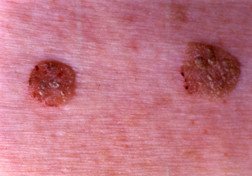Seborrheic keratoses
Medically reviewed by Drugs.com. Last updated on Nov 21, 2023.
What is Seborrheic keratoses?

Seborrheic keratoses are benign (noncancerous) skin growths that develop from skin cells called keratinocytes. These growths have a waxy or greasy look and can be tan, brown or black. They look like they have been glued or stuck onto the skin. Over time, the growths become rough and crusty looking.
|
|
Seborrheic keratoses usually appear alone, but others may develop. They usually are found on the chest and back but can appear anywhere on the body, including the face, scalp and neck.
No one knows what causes seborrheic keratoses, but they become more common with age. Most people will develop some seborrheic keratoses as they get older, and children rarely have them. Seborrheic keratoses are not contagious.
Symptoms
Seborrheic keratoses look like crusty growths on the skin that typically start out tan or brown but can darken over time. They tend to have a greasy appearance and look as though they were glued onto the skin, as opposed to growing from it. They may be tiny, or larger than 3 inches across. They rarely itch.
Diagnosis
Physicians usually can diagnose seborrheic keratoses by looking at them. In rare cases, seborrheic keratoses may look like other skin disorders, including malignant melanoma. If the diagnosis is uncertain, your physician may want to do a biopsy, in which a portion of the growth is removed and examined under a microscope.
Expected duration
Seborrheic keratoses do not go away on their own. If they are not removed, they will last a lifetime.
Prevention
There is no way to prevent seborrheic keratoses from developing.
Treatment
Seborrheic keratoses do not require treatment. Although they may grow relatively large and can become dark, they are not dangerous.
If seborrheic keratoses become irritated, itchy or unsightly or if they bleed, they can be removed in a doctor's office. Because the skin is numbed before any procedure, treatment is mostly painless. The three main methods of removal are:
- Curettage — After the skin is numbed, the growths are sliced or scraped off using an instrument called a curette.
- Cryosurgery or freezing — Liquid nitrogen is applied to the growths. The seborrheic keratoses crust over and then fall off a few weeks later.
- Electrosurgery — An electric current burns the growths off.
When to call a professional
See a health care professional if you develop any unusual skin growths or if existing growths start to change their appearance. If multiple seborrheic keratoses develop suddenly, call your physician's office to schedule an appointment. It may be a sign of another disease.
Prognosis
Seborrheic keratoses do not go away on their own, but they can be removed if they become irritating or unsightly. There is no harm in not treating the growths, because they are benign (noncancerous) and do not become cancerous.
Additional info
American Academy of Dermatology
https://www.aad.org/
Further information
Always consult your healthcare provider to ensure the information displayed on this page applies to your personal circumstances.

